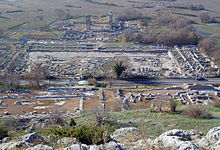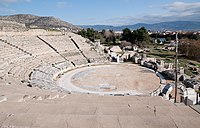Philippi
Φίλιπποι | |
 Ruins of the centre of the city. The forum in the foreground, the market and the Basilica in the background. | |
| Location | Filippoi, Eastern Macedonia and Thrace Greece |
|---|---|
| Region | Macedonia |
| Coordinates | 41°00′47″N 24°17′11″E / 41.01306°N 24.28639°E |
| Type | Settlement |
| History | |
| Founded | 356 BC |
| Abandoned | 14th century |
| Site notes | |
| Official name | Archaeological Site of Philippi |
| Criteria | Cultural: iii, iv |
| Reference | 1517 |
| Inscription | 2016 (40th Session) |
| Area | 87.545 ha |
| Buffer zone | 176.291 ha |
Philippi (
History
Foundation



The
When the Romans destroyed the Antigonid dynasty of Macedon in the Third Macedonian War (168 BC), they divided the kingdom into four separate states (merides). Amphipolis (rather than Philippi) became the capital of the eastern Macedonian state.[4]
Almost nothing is known about the city in this period, but archeological remains include walls, the
Roman era


The city reappears in the sources during the
Following this second renaming, and perhaps after the first, the territory of Philippi was centuriated (divided into squares of land) and distributed to the colonists. The city kept its Macedonian walls, and its general plan was modified only partially by the construction of a forum, a little to the east of the site of Greek agora. It was a "miniature Rome", under the municipal law of Rome, and governed by two military officers, the duumviri, who were appointed directly from Rome, similar to Roman colonies.
The colony recognized its dependence on the mines that brought it its privileged position on the Via Egnatia. Many monuments evidence its wealth – particularly imposing considering the relatively small size of the urban area: the forum, laid out in two terraces on both sides of the main road, was constructed in several phases between the reigns of the Emperors Claudius (41–54 AD) and Antoninus Pius (138–161), and the theatre was enlarged and expanded to hold Roman games. An abundance of Latin inscriptions also testifies to the prosperity of the city.
Early Christian era

The
The development of Christianity in Philippi is indicated by a letter from Polycarp of Smyrna addressed to the community in Philippi around AD 160 and by funerary inscriptions.


The first church described in the city is a small building that was probably originally a small prayer-house. This Basilica of Paul, identified by a mosaic inscription on the pavement, is dated around 343 from a mention by the bishop Porphyrios, who attended the Council of Serdica that year.
Despite Philippi having one of the oldest congregations in Europe, attestation of a
The prosperity of the city in the 5th and 6th centuries was attributed[
In the same age, the Empire rebuilt the fortifications of the city to better defend against growing instability in the Balkans. In 473 Ostrogothic troops of Theodoric Strabo besieged the city; they failed to take it but burned down the surrounding villages.

Already weakened by the
The
Around 969, Emperor
After a brief occupation by the
The city was abandoned at an unknown date. When the French traveller Pierre Belon visited the area in the 1540s there remained nothing but ruins, used by the Turks as a quarry. The name of the city survived – at first in a Turkish village on the nearby plain, Philibedjik (Filibecik, "Little Filibe" in Turkish), which has since disappeared, and then in a Greek village in the mountains.
Archaeological excavation of the site

Although the site was briefly noted by earlier travellers, first modern archaeological description, based on a visit in 1856, was published in 1860 by
See also
References
Citations
- ^ a b Bourchier, James David (1911). . In Chisholm, Hugh (ed.). Encyclopædia Britannica. Vol. 21 (11th ed.). Cambridge University Press. p. 390.
- ^ "Archaeological Site of Philippi". World Heritage Convention. United Nations Educational Scientific and Cultural Organization. Retrieved 10 December 2022.
- .
- ^ "Philippi – Smart Travel". Philippi – Smart Travel. Retrieved 5 December 2020.
- ^ Acts 16:9–10
- ^ Acts 16:12
- ^ Philippians 1:1
- ^ Acts 16:12–40
- ^ Perrot, Georges (1860). "Daton, Néopolis, les ruines de Philippes". Revue archéologique. 1860: 45–52, 67–77.
- ^ Heuzey, Léon; Daumet, Honoré (1876). Mission Archéologique de Macédoine. Paris: Didot. pp. 1–124.
- ^ Collart, Paul (1937). Philippes, ville de Macédoine, depuis ses origines jusqu'à la fin de l'époque romaine. Paris: Boccard. pp. 25–36.
Sources
- Ch. Bakirtzis, H. Koester (ed.), Philippi at the Time of Paul and after His Death, Harrisburg, 1998. (in English)
- Brelaz, C. (2018). Philippes, colonie romaine d'Orient : Recherches d'histoire institutionnelle et sociale. École française d'Athènes. ISBN 9782869582996.
- P. Collart, Philippes ville de Macédoine de ses origines jusqu'à la fin de l'époque romaine, Paris, 1937. (in French)
- G. Gounaris, E. Gounaris, Philippi: Archaeological Guide, Thessaloniki, 2004. (in Greek)
- P. Lemerle, Philippes et la Macédoine orientale à l'époque chrétienne et byzantine, Ed. De Boccard, Paris, 1945. (in French)
- M. Sève, "De la naissance à la mort d'une ville : Philippes en Macédoine (IVe siècle av. J.-C.–VIIe siècle apr. J.-C.)", Histoire urbaine n° 1, juin 2000, 187–204. (in French)
- Ch. Koukouli-Chrysanthaki, Ch. Bakirtzis, Philippi Athens, second edition, 1997. (in English)
External links
- . Encyclopædia Britannica. Vol. XVIII (9th ed.). 1885. p. 746.
- Philippi – Catholic Encyclopedia
- Livius, Philippi Archived 7 October 2014 at the Wayback Machine by Jona Lendering (ancient history)
- Apostle Paul to Philippi: Sowing the Seeds of Christianity






